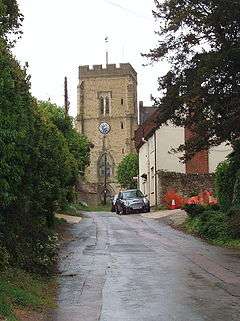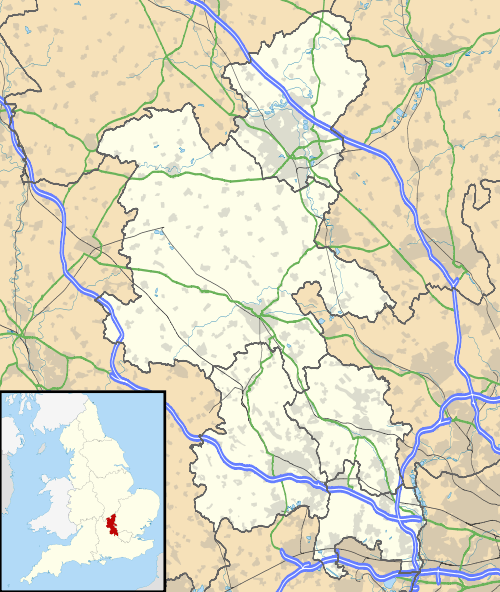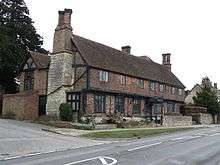Whitchurch, Buckinghamshire
Whitchurch is a village and civil parish in the Aylesbury Vale district of Buckinghamshire, England. The village is on the A413 road about 4 miles (6.4 km) north of Aylesbury and 4.5 miles (7 km) south of Winslow. The 2011 Census recorded a parish population of 932.[1]
| Whitchurch | |
|---|---|
 Church Lane, with the tower of St John the Evangelist's parish church | |
 Whitchurch Location within Buckinghamshire | |
| Population | 932 (2011 Census including Creslow)[1] |
| OS grid reference | SP8020 |
| Civil parish |
|
| Unitary authority | |
| Ceremonial county | |
| Region | |
| Country | England |
| Sovereign state | United Kingdom |
| Post town | Aylesbury |
| Postcode district | HP22 |
| Dialling code | 01296 |
| Police | Thames Valley |
| Fire | Buckinghamshire |
| Ambulance | South Central |
| UK Parliament | |
Toponym
The toponym "Whitchurch" is common in England. It derived from the Old English wit chert, meaning white earth.
Castle
Bolbec Castle was built in the Anarchy in the early 12th century.[2] It was burned down by Parliamentary forces in the English Civil War. Its remains are a scheduled monument.[2]
Parish church
The oldest parts of the Church of England parish church of Saint John the Evangelist are 13th-century.[3][4] They include the chancel and the Early English west doorway.[3] The nave has aisles with four-bay arcades.[3] The south aisle was added first, late in the 13th century.[3] The north aisle was added slightly later, and the south door is early 14th-century.[3] Also 14th-century are the sedilia and piscina in the chancel.[4] The west tower was added in the middle of the 14th century, with its eastern buttresses intruding into the north and south aisles.[5] In the 15th century a Perpendicular Gothic porch was added to the south doorway. Also Perpendicular Gothic are the nave's clerestory and roof,[6] which are late 15th- or early 16th-century.[4] The church is a Grade II* listed building.[4]
The west tower has a ring of six bells. The oldest are the third and fourth bells, which were cast by an unknown bellfounder in 1619.[7] Henry I Bagley of Chacombe, Northamptonshire[8] cast the treble bell in 1680.[7] The other two bells were cast in 1797,[7] but by two different founders. John Briant of Hertford[8] cast the second bell, but Thomas I Mears of the Whitechapel Bell Foundry cast the tenor.[7] The church has also a Sanctus bell, which was cast in 1708 by one of the Chandler[7] family of bellfounders of Drayton Parslow.[8] Sir Edward Smythe (1602–1682), a retired judge who bought the manor of Whitchurch in about 1669, is buried in the church.[9]

Economic and social history

The village used to have a market, which was chartered in 1245. A street of the village is still called Market Hill, and the village still celebrates the granting of its market charter with a May feast each year.
Many of the village's cottages and houses are historic. None is a Grade I listed building but two are Grade II* Listed.[10][11] The Priory in the High Street and The Old House in Church Headland Lane are 15th-century timber-framed houses, each with first-floor jettying.[10][11] The Priory was altered in the 16th, 19th and 20th centuries, has brick nogging, was a hotel (and restaurant "La Boiserie") and is now a private house.[10] The Old House was altered in the 17th century and the front was remodelled around 1940.[6][11]
Nikolaus Pevsner also noted two houses in Oving Road:[6] School House, which is 16th-century, timber-framed and has a jettied first floor;[12] and Whitchurch House, which is early 17th-century and has an early 18th-century façade.[13]
Rex Whistler's painting The Vale of Aylesbury was created in Whitchurch, where a house is now named after him.[14]
The Firs was used as a facility for developing weapons during the Second World War.[15]
Amenities
As well as the Priory Hotel (see above) the village now has one public house: The White Swan, at the end of the high street nearest Aylesbury.
Whitchurch Combined School is a community primary school for boys and girls aged 4–11.[16] The school has about 200 pupils. Its catchment area includes the parishes of Whitchurch, Hardwick, Oving, Pitchcott and Weedon. It also includes part of Watermead and the Berryfields and Weedon Hill Major Development Areas (MDAs) in Aylesbury, although new schools are planned for the MDAs.
Notable residents
- Steve Rothery, musician with Marillion; lives in Whitchurch
- Sir Edward Smythe (1602–1682), former Chief Justice of the Irish Common Pleas; retired to Whitchurch and is buried in St John the Evangelist[17]
- Jan Struther, novelist notable for Mrs Miniver; lived at Whitchurch House
References
- "Parish Headcounts – Whitchurch CP (Parish)". Office for National Statistics. Retrieved 3 February 2013.
- Historic England (15 July 1938). "Bolebec Castle, a motte and bailey castle 300m west of St John's Church (1009536)". National Heritage List for England. Retrieved 21 August 2013.
- Pevsner 1960, p. 292.
- Historic England (21 December 1967). "Church of St John (1124307)". National Heritage List for England. Retrieved 21 August 2013.
- Pevsner 1960, pp. 292–293.
- Pevsner 1960, p. 293.
- Davies, Peter (21 December 2012). "Whitchurch S John Ev". Dove's Guide for Church Bell Ringers. Central Council of Church Bell Ringers. Retrieved 21 August 2013.
- Dovemaster (31 October 2012). "Bell Founders". Dove's Guide for Church Bell Ringers. Central Council of Church Bell Ringers. Retrieved 21 August 2013.
- Ball, F Elrington The Judges in Ireland 1221–1921 London John Murray 1926
- Historic England (25 October 1951). "Priory Hotel (1159973)". National Heritage List for England. Retrieved 21 August 2013.
- Historic England (25 October 1951). "The Old House and attached garden walls (1332786)". National Heritage List for England. Retrieved 21 August 2013.
- Historic England (25 October 1951). "School House (1310748)". National Heritage List for England. Retrieved 21 August 2013.
- Historic England (25 October 1951). "Whitchurch House (1160084)". National Heritage List for England. Retrieved 21 August 2013.
- "The Vale of Aylesbury | Art UK". artuk.org. Retrieved 16 October 2019.
- "Whitchurch Historic Town Assessment" (PDF). Buckinghamshire County Council. Retrieved 23 October 2016.
- Whitchurch Combined School
- Ball, F. Elrington The Judges in Ireland 1221–1921 John Murray London 1926
Sources and further reading
- Page, W.H., ed. (1925). "Whitchurch". A History of the County of Buckingham, Volume 3. Victoria County History. pp. 442–449.CS1 maint: ref=harv (link)
- Pevsner, Nikolaus (1960). Buckinghamshire. The Buildings of England. Harmondsworth: Penguin Books. pp. 292–293. ISBN 0-14-071019-1.CS1 maint: ref=harv (link)
External links
| Wikimedia Commons has media related to Whitchurch, Buckinghamshire. |
